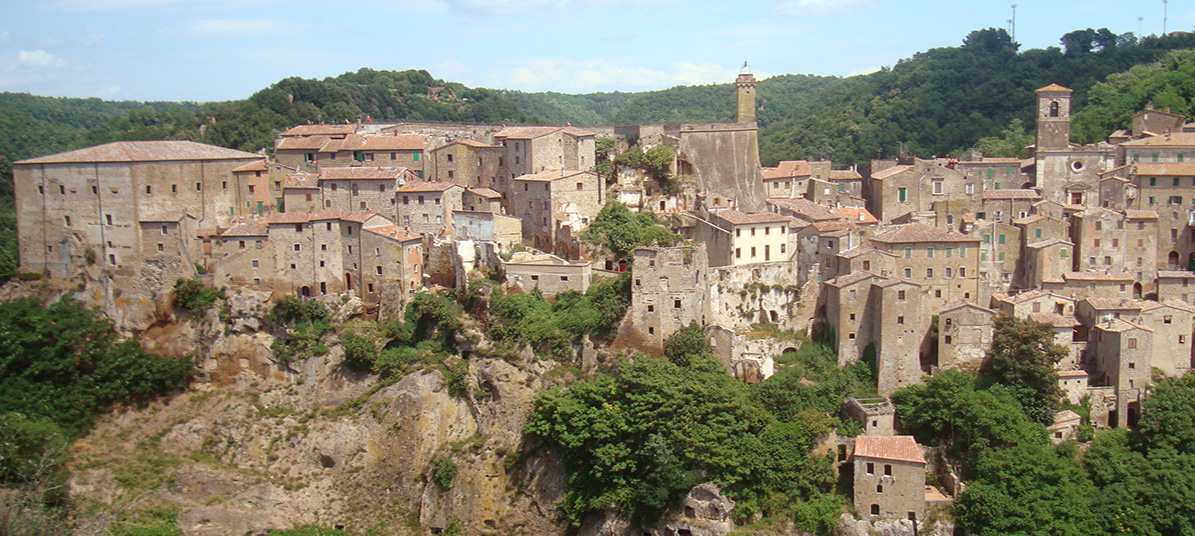| |
| |
|
|
|
|
|
   |
 |
La Bandiera arancione | The Orange Flag towns in Tuscany
The Orange Flag is an eco-environmental quality mark awarded by the Italian Touring Club to small Italian municipalities for excellency in tourism, hospitality and the environment. Approximately 160 towns have so far received this award. In Tuscany these are Anghiari, Barberino Val d'Elsa, Barga, Casale Marittimo, Casole d'Elsa, Castelnuovo Berardenga, Castiglion Fiorentino, Certaldo, Cetona, Collodi, Cutigliano, Lari, Lucignano, Massa Marittima, Montalcino, Montecarlo, Montefollonico, Montepulciano, Monteriggioni, Murlo, Peccioli, Pienza, Pitigliano, Radda in Chianti, Radicofani, San Casciano dei Bagni, San Gimignano, Sorano, Suvereto, Trequanda, Vinci and Volterra.
N e w s
The Orange Flag towns get together on Saturday, 14 and Sunday May 15, in the beautiful scenery of Piazza d'Armi of the Castello Sforzesco in Milan for the second edition of Exploring Orange flags - "Journey into towns to live."
u s e f u l l i n k s
Official website of the Italian Touring Club | www.bandierearancioni.it
Traveling in Tuscany | Complete list of the Orange Flag towns
in Italy
The complete list of Tuscany’s Orange Flag towns is as follows:
In the province of Arezzo: Anghiari, Castiglion Fiorentino, Lucignano.
In the province of Florence: Barberino Val d’Elsa, Certaldo, Vinci.
In the province of Lucca: Barga, Montecarlo.
In the province of Pisa: Casale Marittimo, Lari, Peccioli, Volterra, Pomarance and Castelnuovo Val di Cecina.
In the province of Siena: Casole d’Elsa, Castelnuovo Berardenga, Cetona , Montalcino, Montefollonico, Montepulciano, Monteriggioni, Murlo, Pienza, Radda in Chianti, Radicofani, San Casciano dei Bagni, San Gimignano, Trequanda, Sarteano.
In the province of Pistoia: Collodi, Cutigliano.
In the province of Grosseto: Massa Marittima, Pitigliano, Sorano.
In the province of Livorno: Suvereto.
|
|
travel guide for tuscany
events
exhibitions
art in tuscany
walking in tuscany
wines
films set in tuscany
gardens
the best beaches in tuscany
crete senesi
val d'orcia
market days in tuscany
|
|
| |
|
|
|
Holiday accomodation
|
|
| |
|
|
|
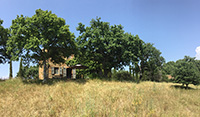
Situated in the spectacular scenario of the Tuscan countryside and hills on the outskirts of Castiglioncello Bandini, Podere Santa Pia is the ideal property for a holiday accommodation and vacation in Tuscany.
Read some reviews
|
|
| |
|
Tuscany’s Orange Flag towns
|
|
|
|
| |
|
|
|
|
|
| |
|
Anghiari is a town and comune in the Province of Arezzo.
Anghiari is famous for the Battle of Anghiari between Florence and Milan which took place there on 29 June 1440. The battle inspired a fresco in the Palazzo Vecchio by Leonardo da Vinci.
The Palazzo del Marzocco hosts the Museum of the Battle and of Anghiari.
Angghiari is also famous for its Artisan’s fair and market (the Mostra mercato dell’Artigianato della Valtiberina Toscana) and the Palio della Vittoria.
There is a walk along the route that leads from Anghiari to Sansepolcro and viceversa, that retraces the steps of the troops who fought in the battle.
|
|
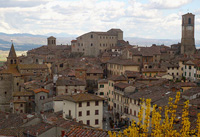
|
|
| |
|
|
|
|
|
| |
|
Barberino Val d'Elsa lies in the heart of Tuscany between Florence and Siena, about 30 kilometres (19 mi) south of Florence. There are a number of historic buildings to visit in Barberino Val d'Elsa such as Palazzo Pretorio with its coats of arms, San Bartolomeo church, the Senese Gate and San Michele Arcangelo chapel.
The Piazza Barberi includes the Church of San Bartolomeo which houses a fragment of an annunciation by the school of Giotto (14th-15th century). The Via Francesco da Barberino leads to the 14th century Porta Senese (Sienese Gate), and the Ospedale dei Pellegrini (Pilgrims' Hospice) dating from 1365.
The Church of Sant'Appiano was built during the 11th century (part in stone) and 12th century (part in brick) and now includes the Antiquarium Museum housing various Etruscan artefacts from the many necropoli in the area, the village of Linari, the Castle of Poppiano at Vico d'Elsa and Petrognano.
The Chapel of San Michele Arcangelo was built in 1597 by Santi di Tito as a perfect 1:8 scale reproduction of the Cupola of the Cathedral of Florence. It was constructed on the site of the ancient city of Semifonte, razed to the ground by the Florentines in 1202. The site remains a focus for archaeological study.
|
|
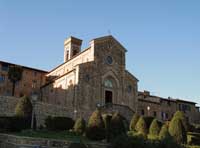
Pieve di Barberino |
|
| |
|
|
|
|
|
| |
|
Barga is situated on the promontory of a mountain spur, in the beautiful forested area of Northern Tuscany. The small town, once known as one of the Jewels of the Garfagnana, has maintained its medieval roots over the centuries, mainly because it is not yet a major tourist attraction.
In the Middle Ages, Lucca and Pisa battled frequently to conquer the flourishing town and the surrounding territory. Florentines also fought for the dominion of Barga and later it became a stronghold of The Medici's Florence. Against the often fiercely independent republic of Lucca, and the Dukes of Este, or ubiquitous Visconti, it was known as Barga Fiorentina.
The Sagra is a feature of Italian rural culture; communal meals for several hundred people, eaten in the open air, often in orchards, vineyards or sports grounds. Originally religious celebrations, they are now often used to raise funds for local causes. Each town and village will have its own peculiar sagra: Around Barga from July to September it is possible to participate in a Sagra every night.
|
|
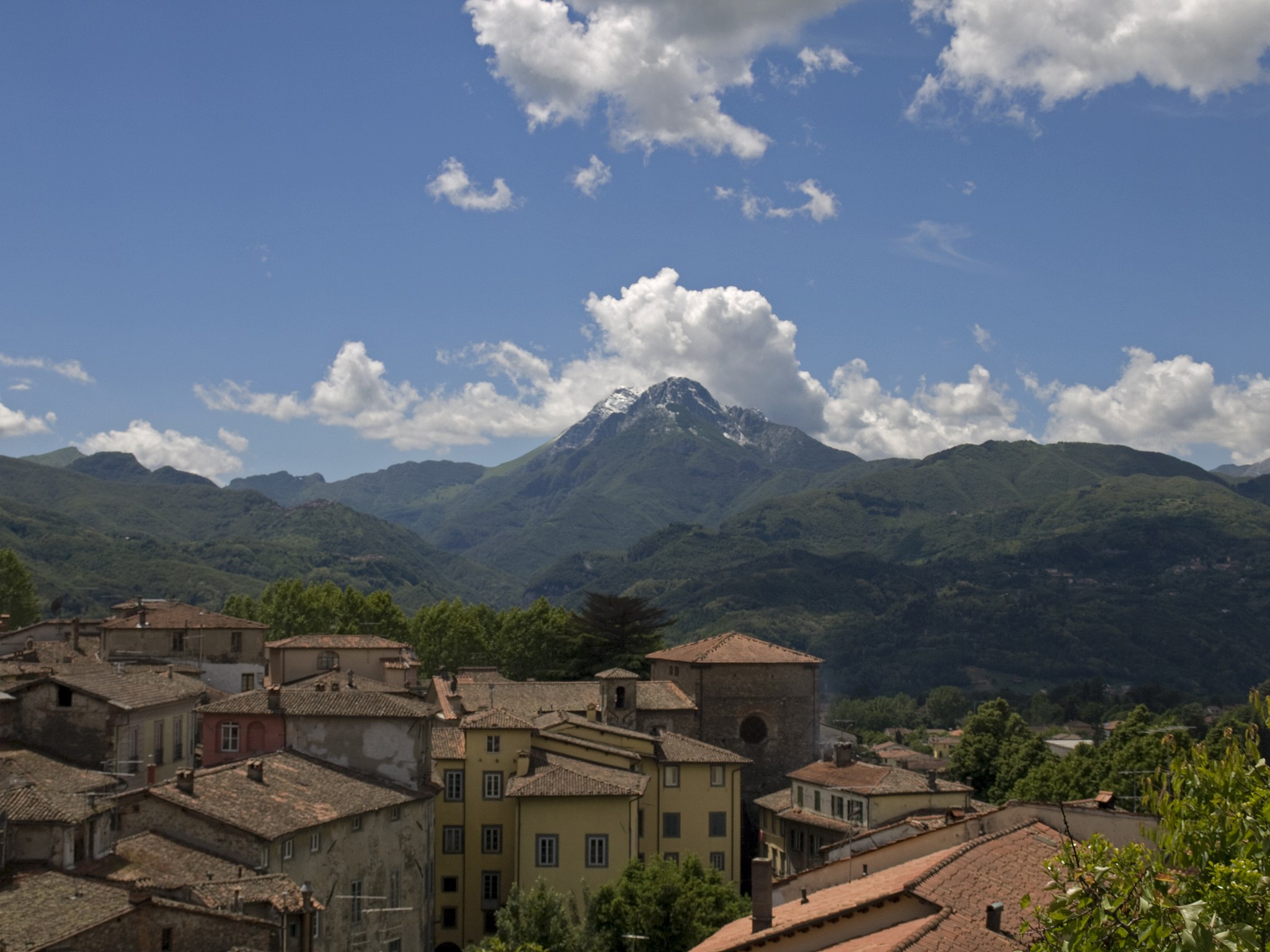
Barga, panorama of the old town taken in the southwest direction |
|
| |
|
|
|
|
|
| |
|
Casale Marittimo is a comune in the Province of Pisa, located about 70 kilometres southwest of Florence and about 50 kilometres southeast of Pisa. Casale Marittimo is home to some incredible natural settings and hidden medieval villages .
Casale Marittimo borders the municipalities Bibbona, Cecina and Guardistallo.
|
|
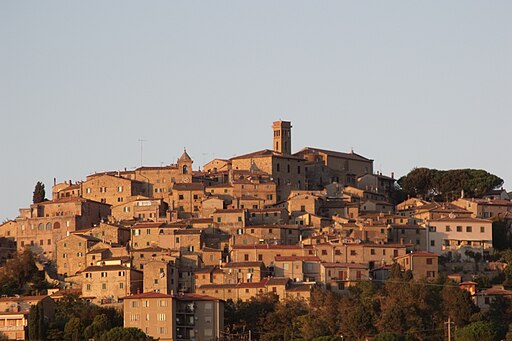 |
|
| |
|
|
|
|
|
| |
|
Just a short way from the main road between Colle Val d’Elsa and Volterra, lies the small hamlet of Casole d’Elsa. Casole d'Elsa, of ancient Etruscan origin, is a small medieval village located 420 m above sea level at the top of the hill. The city was long disputed between Florentines and Volterrans, but the village of Casole owes its impressive walls to the Sienese rule.
The well-preserved defensive walls surround the historic buildings at the heart of the town's life, such as the Rocca, seat of the Town Hall, Palazzo Pretorio and the churches of Santo Spirito, San Pietro and San Niccolò. The heart of Casole is the "piazza Lucchetti", the small central square with its historic buildings dating from the Middle Ages. The church of San Niccolò, of Romanesque origin, has a nave and four aisles divided by columns and semicolumns, with two semicircular apses with mullioned windows. The central portal is from the early 14th century, while the portico is modern. It has 17th-century frescoes by Rustichino and, at the high altar, one 14th century Madonna of the Sienese School.
The view from Casole's high walls is definitely spectacular.
One of he characteristic events which take place every year in Casole d’Elsa is the Palio, a horse race uphill with horses ridden bare-back, particularly difficult both for horses and for jockeys.
|
|
 |
|
| |
|
|
|
|
|
| |
|
|
|
|
|
| |
|
Castelnuovo Berardenga is a comune (municipality) in the Province of Siena, located about 50 kilometres southeast of Florence and about 14 kilometres east of Siena. Since 1932, it is included in the Chianti wine-production area.
Attractions nearby include Abbadia d’Ombrone and Monastero d’Ombrone, the Church of San Giusto and Clemente and the Pieve a Pacina, perhaps one of the oldest churches in the area, Villa di Geggiano and its garden (Villa Bianchi Bandinelli) where Bertolucci shot , the Villa Chigi Saracini, built in the 19th century and surrounded by a beautiful Italian Renaissance garden, Villa di Monaciano and San Gusmè, a quaint medieval village not far from Castelnuovo Berardenga. |
|
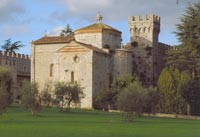
Abbazia d'Ombrone |
|
| |
|
|
|
|
|
| |
|
|
|
|
|
| |
|
|
|
|
|
| |
|
Castiglion Fiorentino is a small, walled city in eastern Tuscany, in the province of Arezzo, between the cities of Arezzo and Cortona. It is well known for its annual festivals and Etruscan archeological site.
The church of Sant Angelo is one of the oldest churches in town. The church was built around the 13th century at the site of an ancient Etruscan temple. The church of San Francesco is one of the most important religious places in Castiglion Fiorentino. The church is mainly known for its beautiful architecture. Although, the size of the church is not quite large it is still quite impressive. The interiors of the church are beautifully decorated with elegant art works and carvings.
In 1513 Vasari constructed a nine arch loggia (Logge del Vasari) in Piazza del Comune, overlooking the valley. Nearby is the Castello di Montecchio, which once was given to the British mercenary John Hawkwood.
Castiglion also has many festivals throughout the year including the famous Palio dei Rioni on the third Sunday of June.
Roberto Benigni, Academy Award-winning actor and director was born in Manciano La Misericordia.
Pilgrim trail Via Romea: Cortona - Pozzuolo.
One of the final sections of the Via Romea in Tuscany goes from Pieve di Sassaia in the territory of Rigutino (Arezzo) through Castiglion Fiorentino to arrive at Cortona. The end point of this section of the path is Pozzuolo, a small town in the area of Castiglione del Lago.
|
|
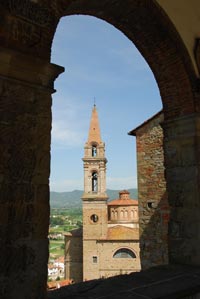 |
|
| |
|
|
|
|
|
| |
|
|
|
|
|
| |
|
|
|
|
|
| |
|
The town of Certaldo is divided into upper and lower parts. The lower part is called Certaldo Basso, whilst the medieval upper part is called Certaldo Alto. Certaldo Alto, a little medieval town is situated on a hill, still surrounded by the medieval city wall, very well-preserved in every detail. Certaldo Alto has limited vehicular access, you can leave the cars at the bottom and take the funicular up to Certaldo Alto.
Certaldo is the village where the poet and writer Boccaccio was born, spent most of his life and died.
The Palazzo Pretorio (Praetorian Palace) is situated at the end of Via Boccaccio, the main street of the village, from where it overlooks the entire hamlet of Certaldo. The Palace was constructed in the 12th century. On the facade of the Palace are various coats of arms of the Vicars of Certaldo, made of terracotta, marble and pietra serena (gray stone). The largest coat of arms in the center of the facade is the Medicean coat of arms. On the right of the facade is a bell tower with a clock of 1484. The museum inside Palazzo Pretorio hosts works of Pier Francesco Fiorentino and the Tabernacolo dei Giustiziati of Benozzo Gozzoli and its school.
Other places of interest in Certaldo Alto are Palazzo Strozzi-Ridolfi, Palazzo Giannozzi, the church of Santi Jacopo e Filippo and Certaldo’s Museum of Sacred Art.
The House of Boccaccio, in the heart of the historic center of Certaldo, is another of the symbols of the city. Boccaccio was a trader and banker but he became famous thanks to his Decamerone, short stories on which Chaucer based his Canterbury Tales. On January 15, 1944, an air raid destroyed almost all of the original building, but it has since been restored to reflect what it likely looked like around Boccaccio’s lifetime. Interestingly, the only part of the house that remained after the attack was a frescoed wall by Pietro Benvenuti. The painting dates from the early nineteenth century and depicts Boccaccio sitting at his writing desk.
As he wished, Boccaccio was buried in Certaldo in the church which today is dedicated to Saint Jacob and Saint Philip.
| |
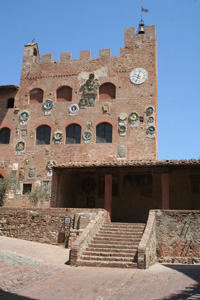
Certaldo, Palazzo Pretorio |
|
| |
|
|
|
|
|
| |
|
Certaldo Alto, main street
|
|
|
|
| |
|
|
|
|
|
| |
|
|
|
|
|
| |
|
|
|
|
|
| |
|
Cetona is located in the southern area of the province of Siena at the base of Monte Cetona. This little town of Etruscan origins still has much of its medieval flavour. Touring Club has assigned the city the Orange flag, aznd ANCI (National Association of Italian Municipalities) has included Cetona among Italy’s most beautiful towns.
Some of the oldest human settlements of central Italy were discovered at the base of Monte Cetona, such as the early neo-Paleolithic Gosto cave (40–80th century BC) and Lattaia cave (9–10th century BC). The Belverde park hosts 25 prehistoric and Bronze Age caves, such as the San Francesco cave. There are several sites of Etruscan finds.
In the first mention of the comune, at the end of the 11th century, Pope Gregory VII granted feudal rights to a member of his family, the Aldobrandeschi. The family's heirs sold the rights,[1] and in the 14th century, Cetona was alternatingly ruled by Siena and Orvieto (until 1354), and, after a brief rule by Perugia, was annexed by Siena. An outer wall was built, containing two round towers (1458). Grand Duke Cosimo I de' Medici of Tuscany sold Cetona in 1556, to the marchese Chiappino Vitelli (1519–75), who made the fortress into a private residence, and built the piazza below it, today named Piazza Garibaldi.
Archeological finds are on display in Museo Civico per la Preistoria del Monte Cetona (in Town), which also administers the Parco Archeologico Naturalistico del Monte Cetona (three km towards Monte Cetona). The Rocca is still privately owned; the other significant hill is occupied by Palazzo a Parco Terrosi (1750), owned by Valentino. Piazza Garibaldi is a magnificent rectangular square developed during the 16th century.
Churches in Cetona are the Chiesa di San Michele Arcangelo (built 1155) and the Chiesa la Collegiata della San Trinita church (1475), as well as the Convento di San Francesco (since 1212) and Convento di Santa Maria a Belverde (frescoes by Cola Petruccioli of Orvieto).
|
|
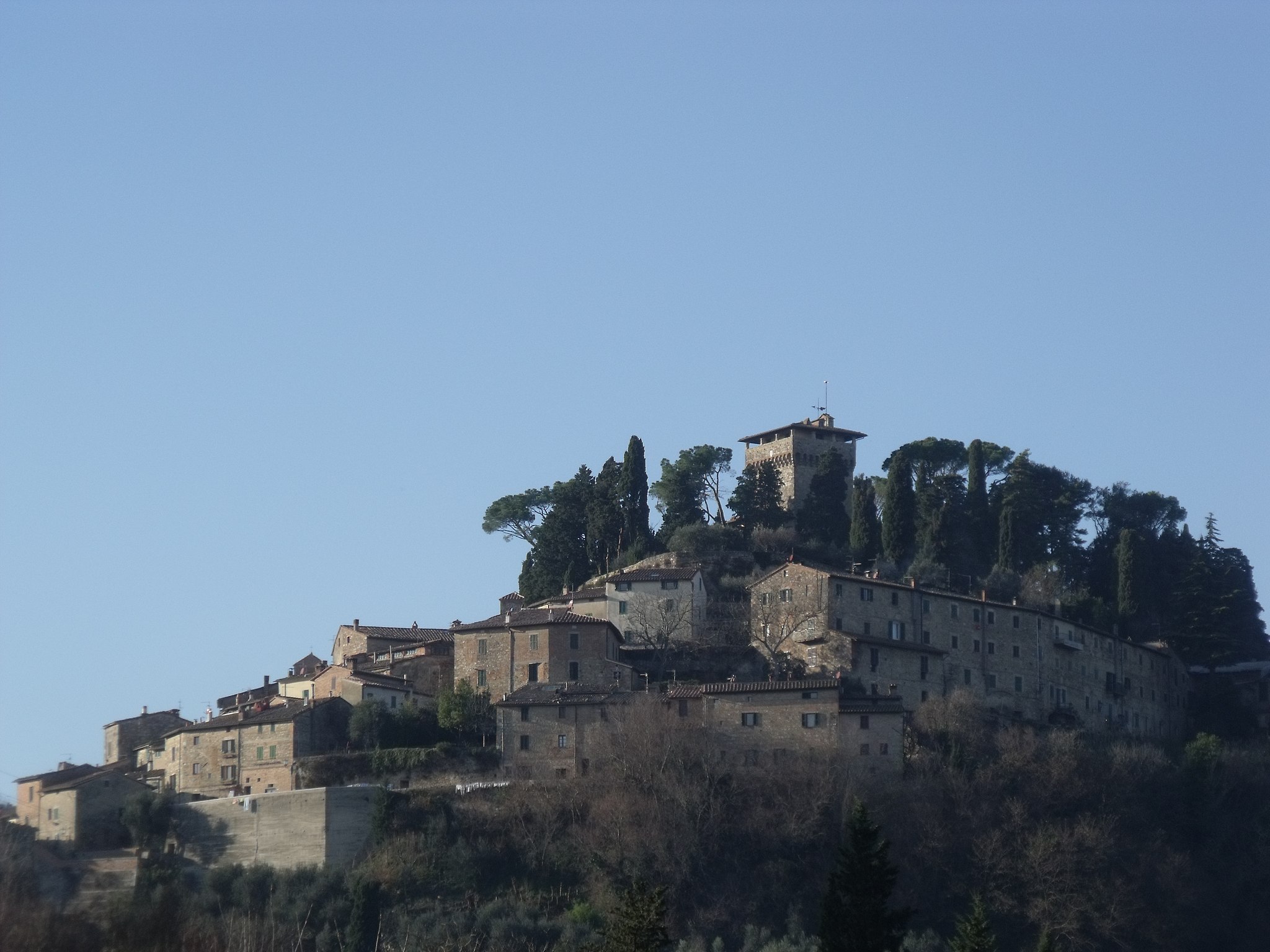
Panorama of Cetona Castle [12] |
|
| |
|
|
|
|
|
| |
|
|
|
|
|
| |
|
|
|
|
|
| |
|
The village of Collodi near Pistoia boasts three distinct attractions. Discover the small village of Collodi and visit the Park of Pinocchio, the Garzoni Garden and the colorful Butterfly House.
Le Avventure di Pinocchio or the Adventures of Pinocchio is the famous fairy tale novel written by Carlo Collodi. Carlo Collodi, who’s real surname was Lorenzini, was born in Florence at the end of the 19th century and not in the village of Collodi, as many people think. Collodi was his mother’s birth-town, the medieval village in which there’s an elegant and Baroque villa, Villa Garzoni. The author’s dad worked there as a gardener and his mother as a waitress.
Villa Garzoni, with its attached coeval monumental garden, is situated at the foot of the ancient medieval village of Collodi, which dates from the late 12th century. The villa, created for Romano Garzoni, is considered one of the most beautiful gardens in Italy and is the result of a work that lasted two centuries, began in the sixteenth century, to transform a simple garden, next to the residence of the Counts Garzoni, in a monumental garden with plants, water and statues.
Inside the Garzoni Garden you can visit the Butterfly House, a large greenhouse with an exotic garden with thousands of tropical butterflies.
Historic Gardens of Villa Garzoni
Piazza della Vittoria, 1
Collodi
|
|
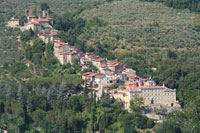
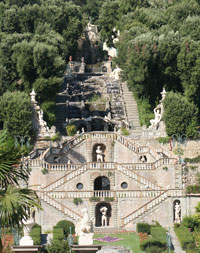
The Garzoni Villa in Collodi, garden
|
|
| |
|
|
|
|
|
| |
|
|
|
|
|
| |
|
|
|
|
|
| |
|
|
|
|
|
| |
|
Cutigliano is a picturesque medieval village in the Tuscan-Emilian Apennines, situated on a spur close to Monte Cuccola, near Pistoia. The still prevalently medieval urban layout is an invitation to stroll about the city. From Piazza Catilina, whose name recalls the defeat of the Roman condottiero, the traditional stroll along Via Roma invites a stop in the small square in front of the Palazzo dei Capitani della Montagna for a short conversation in the shade of the 15th-century loggia.
The yellow façade of the imposing town hall is characterized by the coats of arms of the various Captains of the Mountain that stood here in the past to protect the town.
Also worthy of note in the region, and equally captivating, are Gavinana and its small museum, and Popiglio, famed for the Castruccio bridge.
Cutigliano borders Abetone, Bagni di Lucca, Fanano, Fiumalbo, Piteglio and San Marcello Pistoiese.
|
|

Palazzo dei Capitani, seen from the 15th-century loggia |
|
| |
|
|
|
|
|
| |
|
|
|
|
|
| |
|
|
|
|
|
| |
|
Castello dei Vicari, a Renaissance fortress in the heart of the Tuscan hills, is a great example of military architecture. Every year in May, the cherries festival is held in Lari.
|
|
 |
|
| |
|
|
|
|
|
| |
|
|
|
|
|
| |
|
|
|
|
|
| |
|
Known as the "pearl of Valdichiana", [2] Lucignano is a remarkably conserved medieval walled hill-top village (400 meters above sea level), elliptical in shape. Its altitude and strategic position on the road between Siena and Arezzo meant that between 1200 and 1500 it was continually the subject of battles between these cities, involving also Florence and Perugia. Its walls, with three gates, were constructed by the Sienese in 1371.
Sights include the Collegiata di San Michele Arcangelo (1594) and the Church of San Francesco.
The 2010 film Certified Copy directed by Abbas Kiarostami was set and filmed in Lucignano.
|
|

Lucignano, Chiesa di San Francesco
|
|
| |
|
|
|
|
|
| |
|
|
|
|
|
| |
|
|
|
|
|
| |
|
|
|
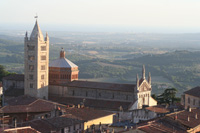 |
|
| |
|
|
|
|
|
| |
|
Montalcino |
|
|
|
| |
|
|
|
|
|
| |
|
|
|
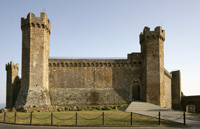 |
|
| |
|
|
|
|
|
| |
|
|
|
|
|
| |
|
|
|
|
|
| |
|
|
|
|
|
| |
|
|
|
|
|
| |
|
|
|
|
|
| |
|
|
|
|
|
| |
|
Montefollonico, chiesa di San Leonardo
|
|
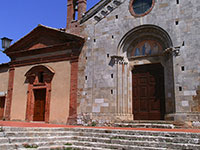 |
|
| |
|
|
|
|
|
| |
|
|
|
|
|
| |
|
|
|
|
|
| |
|
Palazzo Tarugi, Montepulciano
|
|
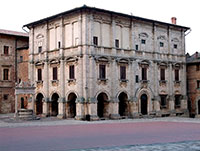 |
|
| |
|
|
|
|
|
| |
|
|
|
|
|
| |
|
The perfectly preserved borgo of Monteriggioni is considered one of the best-preserved medieval towns in Italy.
Every year, in late June, in the castle it is organized the medieval festival Monteriggioni di torri si corona (Monteriggioni is crowned with towers),
Monteriggioniis towers crowned " one of the most important medieval festivals of Italy.Monteriggioni Crowned by Towers Festival
|
|
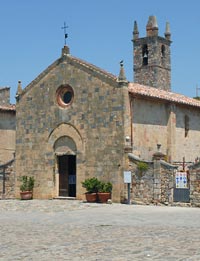 Chiesa di Santa Maria Assunta Chiesa di Santa Maria Assunta
|
|
| |
|
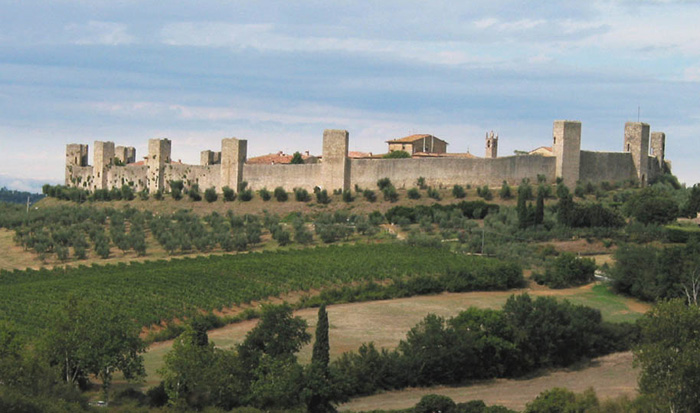 |
|
|
|
| |
|
Monteriggioni
|
|
|
|
| |
|
|
|
|
|
| |
|
|
|
|
|
| |
|
Murlo is a comune in the Province of Siena, situated on a hill at a height of 317 metres, in a commanding position on the watershed dividing the gentle cultivated Crete Senesi and the impervious wooded hills of the Maremma.
There are many monuments and historical buildings to visit in the municipality of Murlo such as Murlo Castle, San Fortunato Church, the Palazzone and the archaeological site of Poggio Civitale where many Etruscan finds have been unearthed. The oldest part of the Murlo castle is the imposing square tower dating back to the 11th century. Later, between the 14th and the 16th centuries, other buildings were added to the tower and eventually the boundary walls were also built.
The hill of Poggio Civitate was an ancient settlement located in the commune and currently the site of archaeological investigations.
|
|
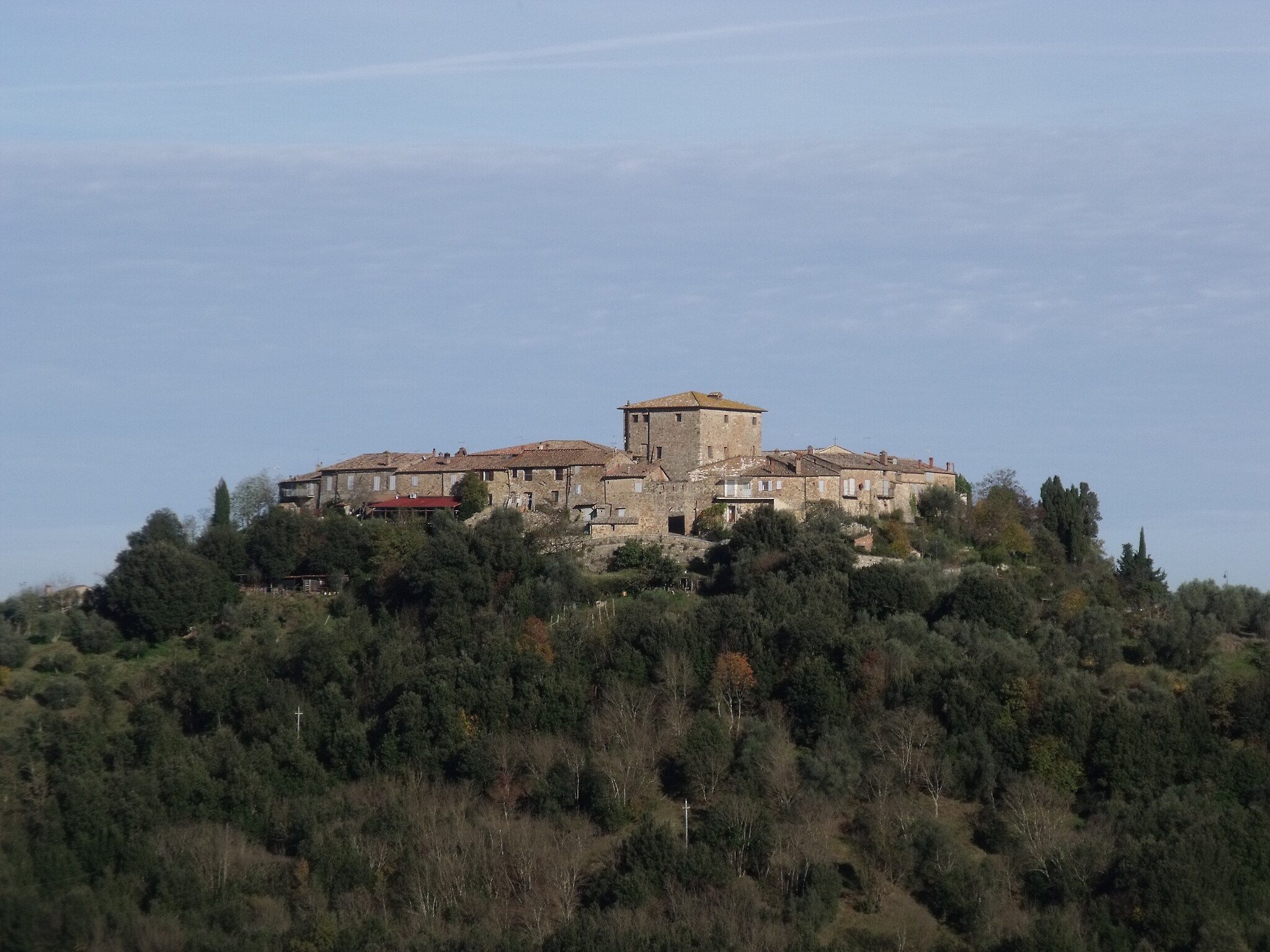
Murlo Castle |
|
| |
|
 |
|
|
|
| |
|
|
|
|
|
| |
|
|
|
|
|
| |
|
|
|
|
|
| |
|
Benozzo Gozzoli, tabernacolo di Legolii, 1479-80, Cappella Sannta Caterina, Peccioli
|
|
|
|
| |
|
Peccioli, in the Italian region Tuscany, located in the Province of Pisa, about 50 kilometres southwest of Florence and about 30 km southeast of Pisa.
Main sights are the Pieve di San Varano, and the Chapel of Santa Caterina in Leccioli, including a late 15th-century tabernacle frescoed by Benozzo Gozzoli when he had moved in the area to escape plague.
|
|
 |
|
| |
|
|
|
|
|
| |
|
|
|
|
|
| |
|
|
|
|
|
| |
|
|
|
 |
|
| |
|
|
|
|
|
| |
|
|
|
|
|
| |
|
|
|
|
|
| |
|
|
|
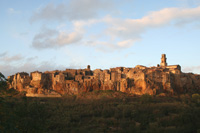 |
|
| |
|
|
|
|
|
| |
|
|
|
|
|
| |
|
|
|
|
|
| |
|
|
|
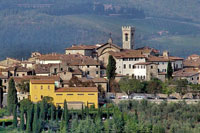 |
|
| |
|
|
|
|
|
| |
|
|
|
|
|
| |
|
|
|
|
|
| |
|
|
|
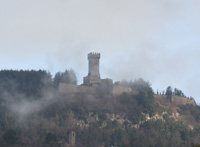 |
|
| |
|
|
|
|
|
| |
|
|
|
|
|
| |
|
|
|
|
|
| |
|
|
|
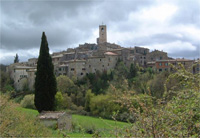 |
|
| |
|
|
|
|
|
| |
|
|
|
|
|
| |
|
|
|
|
|
| |
|
|
|
 |
|
| |
|
|
|
|
|
| |
|
|
|
|
|
| |
|
|
|
|
|
| |
|
Santa Fiora is a small and charming medieval village on the southern slopes of Mount Amiata, where stone walls, alleys, small churches and original buildings have been well preserved. The main characteristic of Santa Fiora is the Peschiera, a small lake that gathers the waters from the Fiora River.
|
|
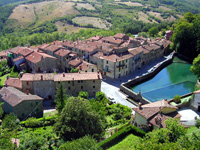 |
|
| |
|
|
|
|
|
| |
|
|
|
|
|
| |
|
|
|
|
|
| |
|
|
|
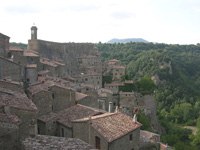 |
|
| |
|
|
|
|
|
| |
|
|
|
|
|
| |
|
|
|
|
|
| |
|
|
|
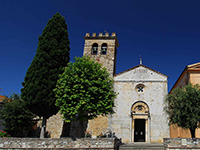 |
|
| |
|
|
|
|
|
| |
|
|
|
|
|
| |
|
|
|
|
|
| |
|
|
|
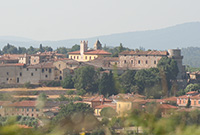 |
|
| |
|
|
|
|
|
| |
|
|
|
|
|
| |
|
|
|
|
|
| |
|
|
|
|
|
| |
|
|
|
|
|
| |
|
|
|
|
|
| |
|
|
|
|
|
| |
|
|
|
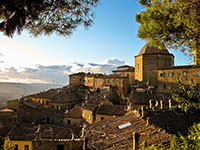 |
|
| |
|
|
|
|
|
| |
|
|
|
|
|
| |
|
Complete list of the Orange Flag towns in Italy |
|
|
|
| |
|
|
|
|
|
| |
|
Abruzzo (5)
• Civitella Alfedena
• Fara San Martino
• Lama dei Peligni
• Palena
• Roccascalegna
Basilicata (2)
• Guardia Perticara
• Valsinni
Calabria (4)
• Bova
• Civita
• Gerace
• Morano Calabro
Campania (4)
• Cerreto Sannita
• Letino
• Morigerati
• Sant'Agata de' Goti
Emilia-Romagna (20)
• Bagno di Romagna
• Bobbio
• Brisighella
• Busseto
• Castell'Arquato
• Castelvetro di Modena
• Castrocaro Terme e Terra del Sole
• Fanano
• Fiumalbo
• Fontanellato
• Longiano
• Montefiore Conca
• Monteleone (frazione di Roncofreddo)
• Pennabilli
• Portico e San Benedetto
• Premilcuore
• San Leo
• Sestola
• Verucchio
• Vigoleno (frazione di Vernasca)
Friuli-Venezia Giulia (2)
• Cividale del Friuli
• Maniago
Lazio (19)
• Arpino
• Bassiano
• Bolsena
• Bomarzo
• Calcata
• Campodimele
• Caprarola
• Casperia
• Collepardo
• Fossanova
• Labro
• Leonessa
• Nemi
• San Donato Val di Comino
• Sermoneta
• Sutri
• Trevignano Romano
• Tuscania
• Vitorchiano
Liguria (14)
• Airole
• Apricale
• Brugnato
• Castelnuovo Magra
• Castelvecchio di Rocca Barbena
• Dolceacqua
• Perinaldo
• Pigna
• Pignone
• Santo Stefano d'Aveto
• Sassello
• Seborga
• Toirano
• Triora
• Varese Ligure
Lombardia (11)
• Bienno
• Castellaro Lagusello (frazione di Monzambano)
• Chiavenna
• Clusone
• Gardone Riviera
• Gromo
• Menaggio
• Pizzighettone
• Sabbioneta
• Tignale
• Torno
Marche (20)
• Acquaviva Picena
• Camerino
• Corinaldo
• Frontino (Italia)
• Genga
• Gradara
• Mercatello sul Metauro
• Mondavio
• Montecassiano
• Montelupone
• Monterubbiano
• Offagna
• Ostra
• Pievebovigliana
• Ripatransone
• San Ginesio
• Sarnano
• Staffolo
• Urbisaglia
• Visso
Molise (4)
• Agnone
• Ferrazzano
• Frosolone
• Scapoli
Piemonte (24)
• Alagna Valsesia
• Avigliana
• Barolo
• Bene Vagienna
• Bergolo
• Candelo
• Cannero Riviera
• Cannobio
• Cherasco
• Cocconato
• Fenestrelle
• Fobello
• Grinzane Cavour
• La Morra
• Macugnaga
• Malesco
• Mergozzo
• Monforte d'Alba
• Neive
• Orta San Giulio
• Santa Maria Maggiore
• Usseaux
• Varallo
• Vogogna
Puglia (13)
• Alberobello
• Alberona
• Bovino
• Cisternino
• Corigliano d'Otranto
• Locorotondo
• Oria
• Orsara di Puglia
• Pietramontecorvino
• Rocchetta S. Antonio
• Sant'Agata di Puglia
• Specchia
• Troia
Sardegna (6)
Bandiera arancione di Aggius.
• Aggius
• Galtellì
• Gavoi
• Laconi
• Oliena
• Sardara
Sicilia (1)
• Petralia Sottana
Toscana (38)
• Anghiari
• Barberino Val d'Elsa
• Barga
• Casale Marittimo
• Casciana Terme Lari
• Casole d'Elsa
• Castelnuovo Berardenga
• Castelnuovo di Val di Cecina
• Castiglion Fiorentino
• Certaldo
• Cetona
• Chiusi
• Collodi (frazione di Pescia)
• Cutigliano
• Fosdinovo
• Lucignano
• Massa Marittima
• Montalcino
• Montecarlo
• Montefollonico (frazione di Torrita di Siena)
• Montepulciano
• Monteriggioni
• Murlo
• Peccioli
• Pienza
• Pitigliano
• Pomarance
• Radda in Chianti
• Radicofani
• San Casciano dei Bagni
• San Gimignano
• Santa Fiora
• Sarteano
• Sorano
• Suvereto
• Trequanda
• Vinci
• Volterra
Trentino-Alto Adige (8)
• Ala
• Caderzone Terme
• Campo Tures
• Ledro
• Molveno
• Tenno
• Ultimo
• Vipiteno
Umbria (9)
• Bevagna
• Città della Pieve
• Montefalco
• Montone
• Norcia
• Panicale
• Spello
• Trevi
• Vallo di Nera
Valle D'Aosta (1)
• Etroubles
Veneto (9)
• Arquà Petrarca
• Asolo
• Malcesine
• Marostica
• Mel
• Montagnana
• Portobuffolè
• Sappada
• Soave
|
|
|
|
| |
|
|
|
|
|
| |
|
|
|
|
|
| |
|
|
|
|
|
| |
|
|
|
|
|
| |
|

[12] Source: Photo by LigaDue, licenziato in base ai termini della licenza Creative Commons Attribuzione-Condividi allo stesso modo 4.0 Internazionale
|
|
|
|
| |
|
|
 |
 |
|
|
